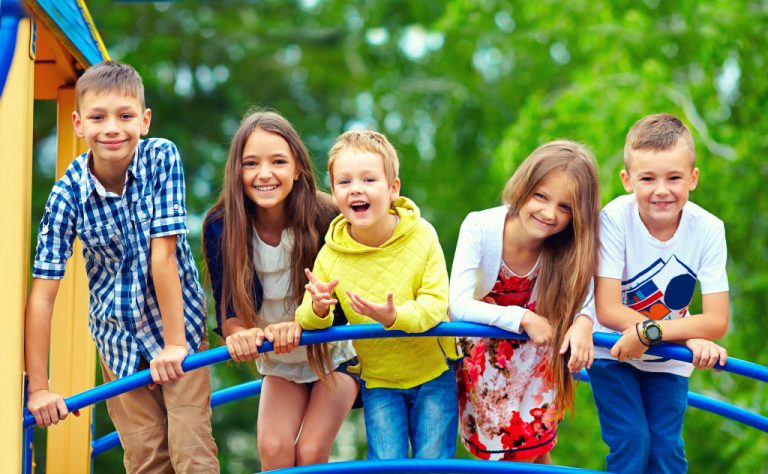- Outdoor activities help to promote physical health and cognitive and social development and allow children to connect with nature.
- There’s a variety of indoor games and activities that can be incorporated into your children’s lifestyle.
- Home environments can be more playful by adding bright colors, whimsical decor, and playful artwork.
- Designated play areas or playrooms encourage kids to engage in play; outdoor spaces should have elements like swings and slides.
- To spark creativity in open-ended play, provide your child with blocks, art supplies, and costumes, or try out equipment rentals.
As parents, it’s an instinct to want the best for your children and to give them everything they need to grow and develop, including their physical and mental abilities. While it’s easy to focus on academics and extracurricular activities, it’s important to remember the power of play in our children’s lives.
Play is essential to a child’s development. It’s when children can learn, explore, and experiment in a safe and enjoyable way. Play helps to build social skills, creativity, and emotional intelligence. Children encouraged to play have improved problem-solving skills, confidence, and more well-developed language skills.
This post will explore the importance of play in a child’s development and provide you with ideas on how to incorporate fun and play into your children’s lifestyle.
Benefits of Outdoor Activities
One of the best ways to incorporate play into your children’s lifestyle is through outdoor activities. Here are some physical health benefits, cognitive and social development advantages, and ways that children can connect with nature and the outdoors:
Physical Health Benefits
Outdoor fun and play extensively impact a child’s physical health. They spend less time on electronic gadgets, use more energy, and exercise their bodies more. Activities such as hiking, biking, and running have short-term and long-term benefits, including improved body metabolism, blood circulation, and muscle growth.
Cognitive and Social Development Advantages
Play isn’t just about improving physical health—it also has tremendous cognitive and social development advantages. Outdoor fun activities such as playing in playgrounds, ball games, and hide and seek help children practice their cognitive flexibility, problem-solving, and decision-making skills.
They could also improve social skills such as communication, teamwork, and healthy competition.
Connecting With Nature and the Outdoors
In today’s tech-savvy world, children can be disconnected from nature. Encourage your children to explore the outdoors and appreciate nature’s beauty.
Children can touch and smell trees, flowers, and fruits while you take them out camping, gardening, bird-watching, fishing, and stargazing. Outdoor activities spark curiosity, learning, and creativity.

Exploring a Variety of Playful Activities
There are numerous ways children can have fun indoors and outdoors. Here are some indoor games and activities, outdoor games and sports, and creative and imaginative play:
Indoor Games and Activities
Rainy or cold days don’t have to stop the fun. There are plenty of indoor games and activities to keep your children entertained. Kids love to play board games, card games, puzzles, video games, and role-playing games. You could also set up an indoor exercise area where they could do yoga, dance, or work out.
Outdoor Games and Sports
Noncompetitive outdoor games are perfect for children to develop physical capabilities while having fun. These include hide-and-seek, tag, obstacle course, scavenger hunt, and DIY water slide. There are several options for sports, including ball games, frisbee, badminton, and tennis.
Creative and Imaginative Play
Creative play is vital for imagination development, especially for younger children. It involves using expressive and artistic materials to experiment with different forms of visual art, paper crafts, storytelling, and imaginative play. Children can explore their creativity with simple crafts such as paper boats, DIY toys, and costumes.
Creating a Playful Environment at Home
The home is where the heart is and can be the perfect place to incorporate fun and play into your children’s lifestyle. You can create a playful environment by adding bright and cheerful colors, whimsical decor, and playful artwork. This can help stimulate your child’s senses and create a positive and inviting space for play.
Designing a Play Area or Playroom
A designated play area or playroom is a great way to encourage your child to engage in play. You can transform a spare room or corner of your home into a play space. Add storage solutions such as shelves and toy boxes to keep the area organized and clutter-free.
You can also add soft and comfortable floor mats or rugs to create a cozy and inviting space for your child to play.
Incorporating Play-Friendly Elements in the Outdoor Space
The outdoor space is perfect for children to engage in imaginative play. You can create a play-friendly outdoor space by adding a sandbox, swings, and slides.
This, in turn, will let your child get physical and engage in play that helps them build gross motor skills, balance, and coordination.
Utilizing Games and Activities Equipment Rentals
Games and activity equipment rentals are a great way to introduce new and exciting play opportunities for your child. You can rent equipment such as bouncy castles, giant board games, and outdoor sports equipment. It allows your child to try new activities and engage in play they may not have previously accessed.
Encouraging Open-Ended Play and Creativity
Open-ended play is vital for a child’s development. It allows them to engage in free play that encourages creativity, imagination, and problem-solving skills. You can promote open-ended play by providing your child with materials such as blocks, art supplies, and costumes that allow them to engage in imaginative play.

By incorporating more fun and play into your children’s lifestyle, you’re giving them powerful tools for development, including physical, cognitive, social, and emotional development.
Play doesn’t have to be complicated, expensive, or time-consuming; it can be as simple as spending time in nature or playing a round of hide-and-seek. Find what works for your children, and enjoy playing and having fun together.



